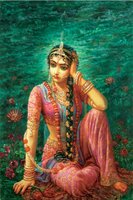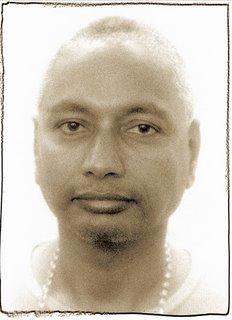 We are made up of energy. A magnetic web of currents that spiral and spin, in every moment our brain and body are communicating and in every moment our subtle body is also expanding and contracting. We are a mystery in motion.
We are made up of energy. A magnetic web of currents that spiral and spin, in every moment our brain and body are communicating and in every moment our subtle body is also expanding and contracting. We are a mystery in motion.Yoga is a science and every science involves experiments to understand the nature of reality. So in Yoga practice the brain is the scientist and the body is the experiment.In order to understand the nature of our body yogic science asks us to believe that we are infinite and concentrated. That we are everything and nothing and that from this state we radiate like rays of the sun touching and sparking everything so that the universe and the stars and the planets and we as nature are manifest.
As this happens both in the macrocosm and the microcosm energy passes through specific phases and states. We move from a void space- like being in the womb as a baby- to a state of growth and activity- as the developing and growing child- to a balanced state of wisdom and intelligence in the mature adult.
These three moving states in Yoga are called the GUNAS, which can be defined as “spiralling vortices of vibrating energy fields” or inherent qualities in nature. They move from a neutral phase ; Sattva ( balance and purity) to a positive phase :Rajas (creative activity) to a negative phase :Tamas( inertia and the point where spirit crystallises into pure matter) When someone dies the body decomposes and returns to the earth and the spirit is set free. In this way Tamas is both the densest form of energy and that, which can free the spirit from the body returning it to its pure sattvic state.
Imagine it like this; The positive pole Rajas and the negative pole Tamas spin around a neutral centre Sattva. In normal life when we are active and creative we are rajasic. Our negative pole Tamas can act like a stabilising force creating a polarity for the excitability of Rajas. The inhale is rajasic it takes us up and out and the exhale is tamasic drawing us down and in…In yoga practice we can learn to cultivate sattva, a neutral space which allows for our activity and for our passivity, to promote a state of active balance.
Tamas
Tamas is solidity, the literal definition being inertia. When we are overly heavy in mind, body and attitudes we are said to be Tamasic. Yogananda shares that the three Gunas can be envisioned as a wave. The wave closest to the centre of the ocean is Sattva, the crest is Rajas and the part that hits the shore is Tamas. What’s ironic is that as soon as the wave hits the shore it is drawn back again to the deepest part of the ocean… In other words everything solid is Tamasic yet the solidity is a temporary illusion because life can transform to the subtlest in an instant.
An apple is real…
When we eat the fruit it converts to energy in our system which creates activity as digestion (rajas), it nourishes us so that we feel more balanced (sattvic) and we eliminate what we don’t need through excretion, through the elements of earth and water (tamasic). What seemed solid when we began eating transforms into earth and water in a matter of hours. This is called the principle of continuity.
The gunas tend to appear stable for a period of time but then transform into each other through the passage of time or through circumstance. Tamas is represented as the night….but night turns to morning, as Rajas, to daylight as Sattva and at sunset to Rajas and then back into the night as Tamas.
This is mirrored in our bodies in the fact that we sleep and are inactive at night and more active during the day. What’s beautiful about purifying and balancing our systems through yoga practice is that we can cultivate an awareness of our natural rhythms; resting when we are naturally tired and being active without draining our selves.
Rajas
The moment you think you encounter Rajas. Rajas means” to glow “When we think a light bulb goes off in our heads. We create heat and sparks with our thoughts. Rajas is the spark that lights the flame and as such it is outward moving, passionate, excited, vital and transformative. That's why thoughts are so powerful as a creative tool.
Rajas is the spark that ignites the varied forms and expressions in the universe. It is pure energy. When we practice we generate energy, we connect with energy and we strive to balance our energy.
What brings energy in? Breath… what sends our energy spinning out of control? Taking on too much, eating foods that imbalance us, not allowing for enough rest and play.
When we are Rajasic in our lifestyle it means we have started to generate too much heat and that natural creative glow becomes a fire out of control. It burns up our nervous system and depletes us. When our thoughts are overly rajasic we can have insomnia and obsessive compulsive tendencies.
We can look at our own stages of development to understand rajas a bit better. When we are babies we are generally sattvic. There is a purity in a baby, you can smell it coming from their crown. As a baby becomes a toddler we see rajas in action. It’s reflected in their speed, their questions and the inability to stop and be with one thing. Then as a teenager we are more tamasic, sleeping for 12 hrs a day, feeling inward and generally inert…As we grow into our young adult hood we become more rajasic again, diving into life and its challenges, studying, relationships, work and then as we move into the latter stage of life there is a need for balance and we strive towards more sattvic ways of being.
Like a wave falling to shore and drawing back the cycles never stop. In focussing in on Rajas however we can acknowledge our creativity and intelligence and how that intelligence sparks inner awareness.
Sattva
The word sattva contains the word Sat, which refers to the universal intelligence that sustains all existence. The sattvic energy field is most apparent when we are feeling harmonious, balanced, open, light and available to the moment. A sattvic person is attractive, healthy, graceful and charismatic. The quality of Sattva attunes us to love and directs our energy back to its source.
When we are Sattvic we are most attuned to the soul, which in yoga is called the “Atman”. The Atman is our soul or the individual drop of the ocean of intelligence called “ Brahman”. What separates the drop from the ocean is our karma. Karma means action and are the actions and reactions we have to the events that inspire us to grow. When we are most balanced we are tuned into what decisions and choices are right for us.
Close your eyes for a moment and imagine a time when you were really happy and everything just flowed; now remember your actions and reactions in that moment and distil the feeling…
Picture a stressful time and notice a change in your response…
Just in these simple few moments of reflection you can sense that in a balanced state life flows and in an imbalanced state there is stress (Rajas) or an inability to shift (Tamas).
Sattva relates more to the mind, to higher mind, which in yoga is called “Buddhi”. It’s your inspiration and intuition guiding you. Becoming more sattvic will enhance your life and your interactions with others.
To become more sattvic we want to work towards purity of the body and the mind. More specifically Ayurveda addresses the physical body through diet and the mental/emotional body through becoming aware of the emotional states. The gunas show that we move from a Tamasic to a Rajasic to a Sattvic state. Understanding the nature of foods and their qualities can support us to become more pure in our diet, understanding the nature of our emotions can help us to become more balanced in the heart and mind.
Heavy foods are Tamasic, spicy foods and junk foods are Rajasic, neutral foods, like vegetables, fruits and grains are sattvic.
Emotions like depression are Tamasic, anger Rajasic and love and peace Sattvic.
The main thing to grasp in practice is to become aware of your approach to asana both physically and emotionally. If you are intensely overworking, you may be too rajasic. If you flop around and don’t activate muscles you may be too tamasic, however if you strive to wards muscular effort and present relaxation you are more likely to find your inner balance.
In yoga it is said that there are 72,000 channels that direct energy or prana in the body. In yoga we focus on three of these channels and they relate directly to Rajas, Tamas and Sattva
In meditation there is a natural upward flow of energy this is shakti ascending on the rajasic current of the inhale. That passage way is called Ida. Ida in ancient greek mythology is the name of a mountain and in Sanskrit it means libation and is sometimes expressed as the channel of comfort. The feminine is comforting and her qualities when soothing us cooling. Hence she is associated with the silver moon
In life there is a natural downward flow of energy, Siva descending on the tamasic current of the exhale. This passage way is called pingala and its is likened to molten lava flowing from a volcano. The word pingala means tawney channel and is also associated with the sun.. Siva is known as the destroyer, he breaks down the creative forces and turns them to dust. Siva is also associated with peace and consciousness. When we are freed from the physical in death it is said we return to being pure awareness.
In our bodies we are experience a sacred marriage as we inhale and exhale, the bridge between the two is said to be a central channel called the sushumna. This is the sattvic force. The yogi enters the sushumna on exhalation and then moves the awareness to the midbrain. In meditation as your breath slows down more and more you feel the pauses at the end of exhalation. So Siva ( awareness) and Shakti ( energy) unite to form a cosmic and intelligent child. ( Brahman) all knowledge and intelligence












